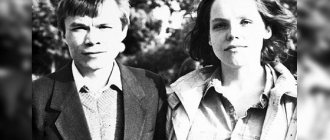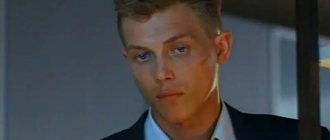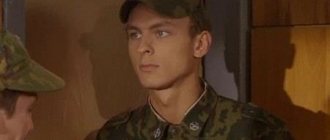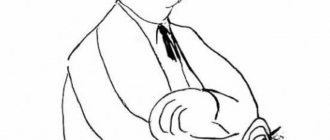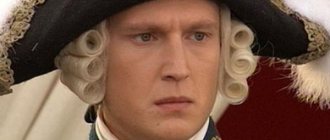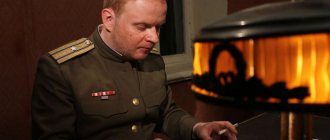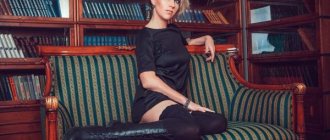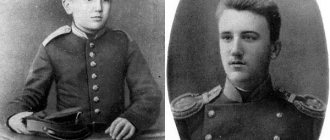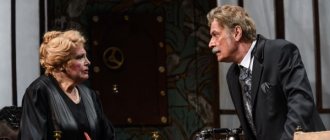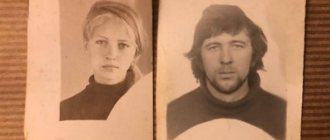Full name: Alexander Leonidovich Kaidanovsky
Date of birth:
July 23, 1946
Zodiac sign:
Leo
Age:
49 years
Place of birth:
Rostov-on-Don
Date of death:
December 3, 1995
Activities:
Actor, director
Height:
175 cm
Education:
Theater School named after.
B. Shchukina Marital status:
Married
Spouse:
Inna Pivars, Irina Anatolyevna Bychkova, Evgenia Simonova, Natalia Sudakova
Children:
Andrey Aleksandrovich Kaidanovsky, Daria Aleksandrovna Kaidanovskaya, Zoya Kaidanovskaya
Alexander Kaidanovsky - biography
Alexander Kaidanovsky is a Soviet and Russian theater and film actor, film director, screenwriter.
Honored Artist of the Russian Federation. Now, after his death, no one questions his highest acting skills in the biography of Alexander Leonidovich. Kaidanovsky was called a brilliant actor by Marcello Mastroianni, Rutger Hauer, Richard Gere, Hanna Schygula, Masha Merrill and Robert De Niro. He was compared to Jack Nicholson and Innokenty Smoktunovsky. Andrei Tarkovsky's film "Stalker", where he played the main role almost thirty years ago, is recognized as a classic all over the world.
Alexander Kaidanovsky... He was always exceptional and at the same time unbearable - both on the set and in life. Torn apart by inner demons, he could not find peace until his death.
Notes[ | ]
- ↑ 1 2 German National Library, Berlin State Library, Bavarian State Library, Austrian National Library
Record #124428835 // General regulatory control (GND) - 2012-2016. - Andrey Kolobaev.
Kaidanovsky's point.
Stalker's first wife - about the mysteries of the most unsolved actor (unspecified)
. Russian newspaper (December 24, 2015). - Interview. Date accessed: February 26, 2021. - ↑ 1 2
Decree of the President of the Russian Federation dated December 8, 1992 No. 1524. On awarding the honorary title “Honored Artist of the Russian Federation” to creative cinema workers
(unspecified)
. Administration of the President of Russia. Date accessed: May 29, 2020. - Memoirs of Evgeniy Khanis
- Kaidanovsky Alexander Leonidovich. 70 years since the birth of Alexander Kaydanosvsky (1946-1995), Soviet and Russian actor, director, screenwriter (unspecified)
. Rostov-on-Don: Municipal libraries (May 20, 2019). Date accessed: May 29, 2021. - Lev Naumov.
Alexander Kaidanovsky and the family of his kerosene worker // Aurora: magazine. - 2021. - No. 3-5. - Andrei Tarkovsky.
Martyrology. - 2008. - ISBN 978-88-903301-0-0. - Artyom Stotsky.
The failed future of the stars
(undefined)
. Express newspaper (April 22, 2015). Retrieved November 3, 2018. Archived November 3, 2021. - Vyacheslav Murygin.
All familiar faces: STALKER characters in the game and in life
(undefined)
.
gsc-fan.com
(February 16, 2013). Date accessed: November 3, 2021. Archived November 3, 2021. - Alexander Kaidanovsky: childhood
- Feat of the People: Lev Lvovich Kaidanovsky (Rostov, August 24, 1945): Junior sergeant, radio operator of the 27th separate company of the Air Force ZOS, medal “For the Defense of the Caucasus.”
- Memoirs of Irina Kaidanovskaya Archived copy from July 10, 2016 on the Wayback Machine
- Lyudmila Bulgakova "My brother - Sasha"
- Lyudmila Bulgakova "My brother - Sasha"
- Candidate of Psychological Sciences I. A. Kaidanovskaya (unspecified)
(inaccessible link). Access date: June 21, 2012. Archived November 11, 2014. - Website about Alexander Kaidanovsky: The film “Rescuer”
- Valery Panyushkin.
Tired of talking nonsense // Matador. - 1996. - Issue. 5.
Childhood and youth, family
Alexander was born on July 23, 1946 in the southern city of Rostov-on-Don.
Father, Leonid Lvovich Kaidanovsky, had nothing to do with art. During the war he was a pilot, fought, and was wounded. After the war, he worked at the Rostov MGB as head of a radar station. In 1945, he married Vera Aleksandrovna Onischuk. Sasha is the child of this initially happy marriage. Mother was an independent and artistic person. Vera Alexandrovna knew literature well, understood music, had a keen ear and a pleasant voice. Sasha looked like her with his wide, charming smile. Rostov, where Alexander spent his childhood, changed hands four times during the war and was destroyed. Not far from his house there was a bombed university library building, in the ruins of which a variety of books could be found. Perhaps, it was then that the young man developed a passion for reading, which he did not change throughout his life.
At the end of the 40s, my father was dismissed from the authorities under the “fifth point”. I went to study at a technical school to become an underwater welding specialist and then spent my whole life building bridges and other hydraulic structures. Alexandra’s mother worked as a librarian, but while studying at the Institute of Culture she became interested in theater and began to try her hand at theater directing.
She did not see artistry in her son and never gave him roles in her children's performances. True, Sasha still managed to play the bunny on the Christmas tree. Perhaps it was in a hidden polemic with his mother that he subsequently decided to become an actor.
Meanwhile, the relationship between the parents began to deteriorate. Leonid Lvovich was terribly jealous. As Alexander recalled, his father, while still an MGB employee, more than once chased his young and beautiful wife with a revolver. Their relationship became especially tense after their mother returned from Moscow. The father could not calmly see artists around his director wife, among whom there were many attractive young people.
Normal family life in such conditions was impossible. In the quarrels of his parents, Sasha served as the object of mutual reproaches and accusations. In 1960, the parents officially divorced. Vera Alexandrovna soon married again. Alexander stayed with his father. Wanting to gain independence, the young man decided to leave Rostov. In Dnepropetrovsk I entered the welding college. He didn’t care where to study - he wanted to get rid of obsessive guardianship and family dramas. The father was triumphant - the son followed in his footsteps.
However, Alexander began to participate in amateur performances, and then entered a theater studio. A year later I dropped out of welding college. His father insisted on continuing his studies, but Kaidanovsky Jr. firmly stated that he had other plans. He didn’t say which ones, because my father hated actors. Secretly from him, Sasha entered the Rostov Theater School. Leonid Lvovich was offended by his action. For several years he could not forgive such betrayal and did not want to watch his son’s acting work.
Alexander studied seriously. He collected records of masters of artistic reading, listened for a long time, and worked for hours on reading and speaking techniques. I was very interested in how poets read poetry - Yevtushenko, Okudzhava, Akhmadulina, Voznesensky, but he himself preferred to read classics from the stage. In the early 60s, Alexander communicated a lot with the Charsky family of Rostov artists.
In this environment, Alexander quickly grew up and became more and more demanding of himself and others. In his intellectual development, he overtook his fellow students, and he became uninterested in school. His teacher abandoned the obstinate student. Kaidanovsky had to switch to another teacher to get his diploma.
After drama school, Alexander was taken to work in the Rostov theater, but at the very first distribution of roles he had a conflict with the director. He asked why he was not offered the role, to which the answer was: “To get the role, you, young man, still need to study and study.” He replied: “We need to study. But only for you - with me,” after which he went to Moscow and submitted documents to GITIS, the Moscow Art Theater School, the Shchepkinsky and Shchukinsky schools.
In three of them, Alexander passed through a creative competition. He preferred the Moscow Art Theater School. However, a month later Kaidanovsky left there: “I can’t study there. I feel like I'm being watched all the time. I’m walking down the corridor - Konstantin Sergeevich (Stanislavsky) is hanging on the left, Vladimir Ivanovich (Nemirovich-Danchenko) on the right, and these portraits look at me with such reproach, I can’t breathe freely!”
After a month of wandering, Alexander was lucky - the rector of the Shchukin School, Boris Zakhava, accepted him into a course that had long been completed. His classmates were Nina Ruslanova, Boris Galkin, Yuri Bogatyrev, Ivan Dykhovichny, Vladimir Kachan, Leonid Filatov.
In March 1966, Kaidanovsky got married. He was friends with his chosen one, Irina Bychkova, throughout his years of study at the Rostov Theater School. Six months later she moved to Moscow with him. They rented rooms where Sasha’s classmates visited them, as well as Rostov friends - artist Alexey Charsky, psychologist Vera Shchur, geneticist Evgeny Guskov, musician Alexander Orekhov, theater director (now great) Anatoly Vasiliev.
Study and friendship with Filatov
In the capital, Kaidanovsky also did not immediately find his theater institute. At first I chose the Moscow Art Theater, but after studying for only a short time, I transferred to Shchuka.
Here Alexander met the future stars of Soviet cinema. He especially became friends with L. Filatov. Both artists were distinguished by their erudition and liveliness of mind. And, despite his courtyard upbringing and arrogant manners, Kaidanovsky amazed Filatov with his high knowledge in a variety of fields. They could discuss all night long on a variety of topics.
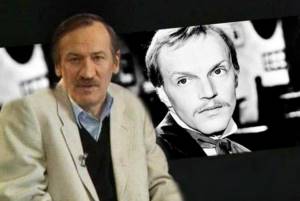
Leonid Filatov’s program “To Remember,” dedicated to A. Kaidanovsky.
The star friend also recalled how fearless Kaidanovsky was when it came to risk and danger. They formed a strong male group of artists - Boris Galkin, Vladimir Kachan, Alexander Kaidanovsky, Leonid Filatov and a certain artist Matveev.
Late one evening they encountered a gang. The thugs had knives. Kaidanovsky approached one of them and took the blade with his hand. Blood gushed out, but the actor did not show pain and did not let go of the knife, he just looked at the hooligan in a particularly frightening way. The gang was shocked, its members hastened to retreat.
Carier start
In 1967, Alexander was invited to play the role of Hamlet at the Aksenova-Ardi Experimental Theater.
He coped with the role brilliantly, but critics were wary of Kaidanovsky’s proposed interpretation of the role, although they noted the talent, intelligence and toughness of the performance. But they noticed him and began to invite him to the cinema. Kaidanovsky auditioned for the role of Rodion Raskolnikov with Kulidzhanov, Alyosha Karamazov with Pyryev, and soldier Golubkov in the film “Running” by Alov and Naumov. But he was not chronically approved. The actor looked too unusual, not fitting into the usual role of a positive hero. He seemed too independent and willful.
First roles, films
At the age of 21, Kaidanovsky, for the first time in his acting biography, starred in an episode in the film by Povolotskaya and Sadkovich “The Mysterious Wall”, then with Zarkha in “Anna Karenina”.
His first roles, associated with fantasy and mysticism, mysteriously left a stamp on all his further work. In Mikhalkov-Konchalovsky’s film based on Turgenev’s novel “The Noble Nest,” Alexander played in the episode “Singers,” transferred from “Notes of a Hunter.” The episode was not included in the final cut, but it was this role that drew the attention of Andrei Tarkovsky to him, who wanted to cast Kaidanovsky in all his next films, starting with Solaris. Their collaboration was destined to take place only eight years later. In the meantime, Alexander finished his studies and was invited to the Theater. Vakhtangov. At the same time, his father unexpectedly died after an unsuccessful operation.
While still at school, Kaidanovsky began to write and then stage his own theatrical compositions based on Bulgakov and Pushkin. His style of thinking inevitably led him to directing.
In 1970, a two-part television film “Drama on the Hunt” based on Chekhov was released. Kaidanovsky played Count Karneev. This was his first significant role on television. In the same year, Alexander’s daughter Daria was born in his personal life. Sasha was incredibly happy, but his life was already firmly connected with cinema, and he paid less attention to his family, often and for a long time leaving for filming. Films with his participation began to be released one after another, and he began to be recognized on the streets.
And he had an affair with the most fatal woman of the then theatrical Moscow, Valentina Malyavina. Alexander completely lost his head from this unexpected love. He left theater after theater. After the Theater. Vakhtangov Kaidanovsky worked at Malaya Bronnaya, at the Moscow Art Theater. After which he decided that playing in the theater was not his business, and left the theater forever. They separated from Irina Kaidanovskaya, and soon the ill-fated romance with Malyavina ended.
At this time he was drafted into the army. Alexander served in a cavalry regiment and became an excellent rider, physically strong, coordinated and dexterous. He performed the most desperate stunts on the set without stunt doubles. In the film “A Friend Among Strangers, a Stranger Among Our Own,” Alexander ran across the roofs of a train rushing at full speed, climbed down a rope, broke a window and jumped into the carriage.
Kaidanovsky was vying with each other to be invited to star in the roles of foreigners, former and current aristocrats. The most notable roles of this period: Mr. Astley in Batalov’s film adaptation of Dostoevsky’s story “The Gambler”, Lieutenant Lemke in the already mentioned film “A Friend Among Strangers, a Stranger Among Friend” by Nikita Mikhalkov.
And here is Mikhalkov’s opinion, expressed more than twenty years later:
“Kaidanovsky was a wonderful artist.
One of the few who could, as they say, play on one string. Here you need to have enormous concentration and concentration of the inner world. And he knew how to do it. His self-restraint allowed him to play virtuoso melodies on one string - this, of course, is a rare gift.” “One among strangers” brought Alexander all-Union fame. His character was distinguished by subtlety of reactions, nobility of behavior and cold aristocracy. This aristocracy made Kaidanovsky the first “White Guard” of Soviet cinema. The most notable role of this period is Count Vorontsov in Diamonds for the Dictatorship of the Proletariat.
Filmography[ | ]
Acting works[ | ]
- 1967 - The Mysterious Wall (dir. I. I. Povolotskaya, M. N. Sadkovich) - Someone
- 1967 - Anna Karenina (dir. A. G. Zarkhi) - Jules Lando
- 1968 - First love (dir. V. S. Ordynsky) - Maidanov
- 1969 - The Noble Nest (the episode with Kaidanovsky’s participation was not included in the film)
- 1970 - Drama on the hunt (dir. B. E. Nirenburg) - Count Alexey Karneev
- 1970 - Red Square (dir. V. S. Ordynsky) - soldier
- 1970 - A calm day at the end of the war (short film, directed by N. S. Mikhalkov) - sergeant
- 1971 - And there was evening, and there was morning... (dir. A. A. Saltykov) - midshipman
- 1971 - The Hound of the Baskervilles (dir. A. Zinoviev) - Jack Stapleton
- 1972 - Fifteenth Spring (dir. I. S. Tumanyan) - liaison
- 1972 - Player (dir. A. V. Batalov) - Astley
- 1972 - Fourth (dir. A. B. Stolper) - Second
- 1972 - The investigation is being conducted by experts 6. Blackmail - Mirkin
- 1972 - The Mathematician and the Devil (short story from the almanac "Horizon", issue 2, directed by S. Raitburt) - The Devil
- 1973 - Children of Vanyushin (dir. E. I. Tashkov) - Konstantin
- 1973 - The collapse of engineer Garin (dir. L. A. Kvinikhidze) - Dr. Wolf
- 1973 - Past and Thoughts (dir. L. Elagin) - critic Vissarion Belinsky
- 1974 - One among strangers, a stranger among one's own - Captain Lemke
- 1974 - Following my course (dir. V. G. Lysenko) - Misha
- 1974 - When the wrath of fate befell me... (short film, directed by V.V. Brovkin)
- 1975 - The Lost Expedition (dir. V.D. Dorman) - officer Zimin
- 1975 - My home is a theater (dir. B. V. Ermolaev) - A. N. Ostrovsky
- 1975 - Under the roofs of Montmartre (dir. V. M. Gorikker) - Raoul
- 1975 - Diamonds for the dictatorship of the proletariat (dir. G. E. Kromanov) - Vorontsov
- 1976 - Bridge of Fire - Gennady Dubravin, lieutenant (dir. B. Nirenburg)
- 1976 - Golden River (dir. V.D. Dorman) - Zimin
- 1976 - How important it is to be serious (dir. A. A. Belinsky)
- 1976 - My business (dir. L. G. Maryagin)
- 1977 - Who will go to Truskavets (dir. V. Akhadov)
- 1977 - It was in Kokand (dir. U. E. Nazarov) - Zaichenko
- 1978 - The Life of Beethoven (dir. B. D. Galanter) - Anton Schindler, Beethoven's secretary
- 1978 - Turn (dir. V. Yu. Abdrashitov)
- 1979 - Inquest of Pilot Pirx - neurologist and cyberneticist Tom Novak
- 1979 - Bodyguard (dir. A. Khamraev) - Mirzo
- 1979 - Stalker (dir. A. A. Tarkovsky) - Stalker
- 1980 - The Story of an Unknown Man (dir. V. Žalakyavičius) - Vladimir
- 1980 - Rafferty (dir. S. Aranovich) - Prosecutor Ames
- 1980 - Rescuer (dir. S. A. Solovyov) - Nikolai Varaksin, documentary director (voiced by A. Romashin[16])
- 1980 - Fact (dir. Almantas Grykevicius) - Stanislav
- 1981 - And I’m with you again (dir. B. Galanter) - reads poetry on behalf of the Decembrist N.V. Putyata
- 1982 - Excuse me, please (dir. V. P. Zhalakyavichyus) - Pranas
- 1982 - Department - Orlov
- 1982 - Brothers (film)
- 1987 - Ten Little Indians (dir. S. S. Govorukhin) - Philip Lombard
- 1987 - Khareba and Gogi (dir. G. N. Shengelaya) - Prince Olshevsky
- 1988 - New adventures of the Yankees at the court of King Arthur - Lancelot
- 1992 - November (Poland-France) (dir. L. Karwowski)
- 1992 - The Devil's Breath (Spain) (dir. Paco Lucio)
- 1994 - Magic Hunter (Magic Shooter), (Hungary) (dir. I. Enyedi)
- 1995 - Revelations to a Stranger (France-Russia) (dir. J. Bardawil) - Kryuchkov
- 1995 - Wedding March (short story from the film anthology “The Arrival of a Train”) (dir. A.F. Hwang)
Voice acting for cartoons[ | ]
- 1977 - Forward, time! (dir. V.I. Tarasov) (reads the text)
- 1980 - Return (dir. V. Tarasov) (uncredited)
- 1985 - Contract (dir. V. Tarasov)
- 1985 - Two tickets to India (dir. R. A. Kachanov)
- 1988 - Pass (dir. V. Tarasov)
- 1992 - The Dream of a Funny Man (dir. A.K. Petrov)
Film scoring[ | ]
- 1982 - Condor / Dögkeselyű (Hungary, directed by F. András)
- 1984 - An incredible bet, or a true incident that ended successfully a hundred years ago - law student (role of B. G. Plotnikov)
- 1985 - Simple Death - Ivan Ilyich (role of V. M. Priyomykhov)
- 1988 - Kerosene man's wife - Vasily Petrovich (role of N. Ispolatov)
Director's work in cinema[ | ]
- 1983 - Jonah, or the artist at work - director. Course work created at the end of the 3rd year of S. A. Solovyov’s workshop, based on the story of the same name by A. Camus, script written jointly with G. I. Rerberg
- 1983 - The Garden (based on the story by H. L. Borges “The Garden of Forking Paths”)
- 1985 - Simple Death... - director, screenwriter. Thesis based on L. N. Tolstoy’s story “The Death of Ivan Ilyich”
- 1987 — Guest — director, screenwriter (based on the story by H. L. Borges “The Gospel of Mark”)
- 1988 - Kerosene Man's Wife - production director, screenwriter
- 1989 - Maestro: Sergei Parajanov - director, screenwriter
- 1989 - For a Million - director, screenwriter (video clip for the German group Alphaville)
- 1992 - Bronze Christ - artistic director
- 1992 - Everything ends, only love - never - artistic director
- 1993 - Defloration - artistic director
- 1995 - Garson No. 2 - director, screenwriter (video clip for B.B. Grebenshchikov and the Aquarium group)[17]
Directing
But soon Kaidanovsky got tired of the endless series of cinematic lieutenants.
He was cramped within the circumstances that the cinema of that time offered. If the role did not carry an in-depth, sometimes ruthless analysis of the human personality, he refused to act. Alexander was increasingly attracted to film directing. He began to think about entering the Higher Courses for Scriptwriters and Film Directors. But then something happened in Kaidanovsky’s personal life that changed his plans. On the set of the film “The Lost Expedition” he met the young actress Evgenia Simonova. She treated the profession as responsibly as he did, hated approximation and laxity. Mutual interest grew into true love, and in 1975 they got married.
For the next two years, in order not to separate, they tried to act together. On the set of “The Importance of Being Serious,” Evgenia had a hard time - she was already in the last months of pregnancy. On November 5, 1976, the couple had their daughter Zoya. Around the same time, Kaidanovsky received an invitation from Andrei Tarkovsky to play the main role in Stalker.
Throughout his entire biography, he moved towards this role - a revelation, a philosophical credo, the pinnacle of mastery. And he turned out to be up to the task. Kaidanovsky played this role brilliantly. But Tarkovsky revealed in him what Alexander did not like and was embarrassed to show: insecurity, vulnerability, severe psychological trauma. This is probably why he did not like to review this masterpiece.
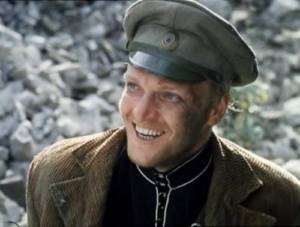
After Stalker, Alexander acted only in two cases - either in films of outstanding directors that were interesting to him, or when he had no means of subsistence at all. Due to the troubles, Kaidanovsky’s personal life went awry: his marriage to Evgenia Simonova broke up - they lived together for seven years.
The role of Stalker brought worldwide fame to Kaidanovsky's biography. International festivals vied with him to invite him. But after his only trip to Poland, the KGB made him travel restricted. They didn’t even extend invitations to him, considering it unnecessary. When Alexander was approved by Tarkovsky for the main role in Nostalgia, he was not released to Italy. After this, he finally decided to break with the acting profession.
Kaidanovsky entered the Higher Courses for Scriptwriters and Film Directors. However, there was no need to teach him anymore. From 1983 to 1988, he made five films: “The Garden,” “Jonah, or the Artist at Work,” “A Simple Death,” “The Guest,” and “The Kerosene Man’s Wife.” Strange and unusual films that require an intelligent, ironic, and empathetic viewer. Alexander himself wrote scripts, directed, and selected music for his films. He was an author in the full sense of the word. His paintings are phantasmagoric and incredible. Strange events in them occur on their own, as an integral part of everyday reality. As part of his own life.
Alexander gradually overcame the powerful influence of Tarkovsky, which was felt in his first directorial works. His authorial style was compared to the films of Luis Buñuel, Jean Cocteau, Federico Fellini, Robert Bresson, Pier Paolo Pasolini. His films enjoyed well-deserved success at international film festivals. But at home they were not successful either with the mass public or with critics. However, this did not bother Kaidanovsky. During these years, he was no longer worried about anything except art.
He was completely “non-existent” in Mandelstam’s sense of the word. He didn't care what suit or shirt he was wearing, as long as the clothes were clean. While working on the next script, Kaidanovsky could live on sandwiches and tea for weeks. Of course he liked comfort. But the idea that time should be wasted for the sake of convenience and comfort disgusted him. Therefore, Alexander walked with royal majesty in a tattered robe with a bare shoulder, like a Roman patrician. At the same time, he behaved equally simply at the Cannes Film Festival and in the communal apartment, where he lived for the last 14 years in a room with 48 stucco angels on the ceiling.
Personal life
Kaidanovsky's relationships with women in his personal life were simple-minded and confusing.
Sasha quickly fell in love, creating an image of his beloved that had little correlation with a living person. He always wanted to marry the woman he liked. Despite his sober and distrustful mind, he remained a romantic in relationships with women. And they loved him very much: Kaidanovsky had incredible attractive power, amazed with his talent, unexpectedness of actions, intelligence, and erudition. But they wanted comfort, comfortable living conditions, and the opportunity to own it alone. His romanticism did not withstand real circumstances. Women turned out to be different from his ideas about them. He was losing interest in them. Marriages ended badly.
Alexander Kaidanovsky first married in Rostov to Irina Bychkova. Alexander's second wife was the famous actress Evgenia Simonova. The third marriage took place with Natalya Sudakova. All marriages ended unsuccessfully, despite the fact that children were born in each of them. Kaidanovsky's fourth and last wife is the young actress Inna Pivars, whom they married three weeks before the actor's death.
At the time of his passion for painting, Alexander Kaidanovsky painted his ceremonial family portrait with a cat and a dog. The three of them sit next to each other at the table and look at the viewer. It is noteworthy that everything is written in reverse proportion - a large cat and a dog and a smaller one - Sasha in the legendary robe. Surprisingly, the animals turned out very similar. Alexander wrote his own features less carefully.
In recent years, the fate of Kaidanovsky’s biography has been tragic. In the early 90s, like most filmmakers, he could not find money for his films. One after another wrote scripts. I tried to create my own theater in the House of Scientists, my own film studio, and a fund to support young filmmakers. He was invited to teach at the Theater School. Shchukin - he responded with gratitude, but this did not give him real satisfaction.
Alexander grabbed onto any movie proposals that seemed interesting to him: a video clip for Boris Grebenshchikov’s song “Garson No. 2” or a film about Tuvan shamans; a film based on Franz Kafka's novel “The Trial” or the story of a man obsessed with a manic passion for vagrancy. Kaidanovsky wrote eight or ten unique scripts.
These would probably be outstanding films in Kaidanovsky’s favorite genre - magical realism. He managed to accomplish almost nothing. Realizing that he would not be able to find funds for his films, Sasha decided to earn them himself - he began acting again, fortunately, offers from all over the world continued to come in, and the Soviet authorities, who would not let him go abroad, were no longer there.
Kaidanovsky filmed in Poland, France, Spain, and Hungary. After filming in Spain, where Alexander played the main role in the film “The Devil’s Breath,” he finally decided to change his communal room for something more comfortable. Sasha bought a two-room apartment on Sivtsev Vrazhek. He invested the rest of the money in financing his new film, which he had been dreaming about for several years. But his money mysteriously disappeared into a supposedly busted bank. It was a blow from which Sasha was never able to recover.
Last years. death
On November 1, 1994, Sasha suffered his first heart attack.
Meanwhile, his popularity around the world grew. The director of the Cannes Festival Gilles Jacob, Clint Eastwood and Catherine Deneuve invited him to participate in the jury. This was recognition of Kaidanovsky’s contribution to world cinema. It was with his participation that the jury of the Cannes Film Festival awarded the Palme d'Or to Quentin Tarantino's film Pulp Fiction. On August 1, 1995, Alexander Kaidanovsky suffered a second heart attack. I couldn't stand the third one. Three heart attacks, almost in a row, were the cause of death of the still young, talented actor. He was 49 years old.
Kaidanovsky did not have time to move into his apartment on Sivtsev Vrazhek. He died in a communal apartment on Vorovskogo Street on December 3, 1995. When friends gathered there for the wake, his huge room, previously filled with books, paintings and records, was empty. Absolutely everything was taken out of it. A pair of empty frames hung forlornly on the walls, plaster angels from the ceiling looked down in surprise, and the trellis of the cat Nosferatu gleamed dimly like a bubbling amalgam...
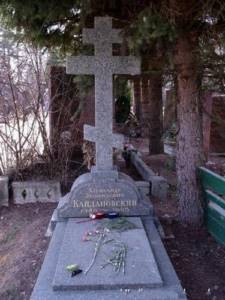
Literature[ | ]
- Fedor Razzakov.
Star tragedies: mysteries, fates and deaths. - M.: Eksmo, 2000. - 400 p. — ISBN 5-04-004335-X. — ISBN 5-04-004333-3. - Sergei Medvedev.
Alexander Kaidanovsky. Diagnosis: genius // Who's in charge: magazine. - Rostov-on-Don, 2007. - No. 10. - Irina Zaichik.
One among strangers // Ogonyok: magazine. - M., 1998. - July 12 (No. 27). — P. 16. - Alexander Kaidanovsky. In memories and photographs / Comp. E. V. Tsymbal. - M.: Art, 2002. - 264 p. — ISBN 5-85200-141-4.
